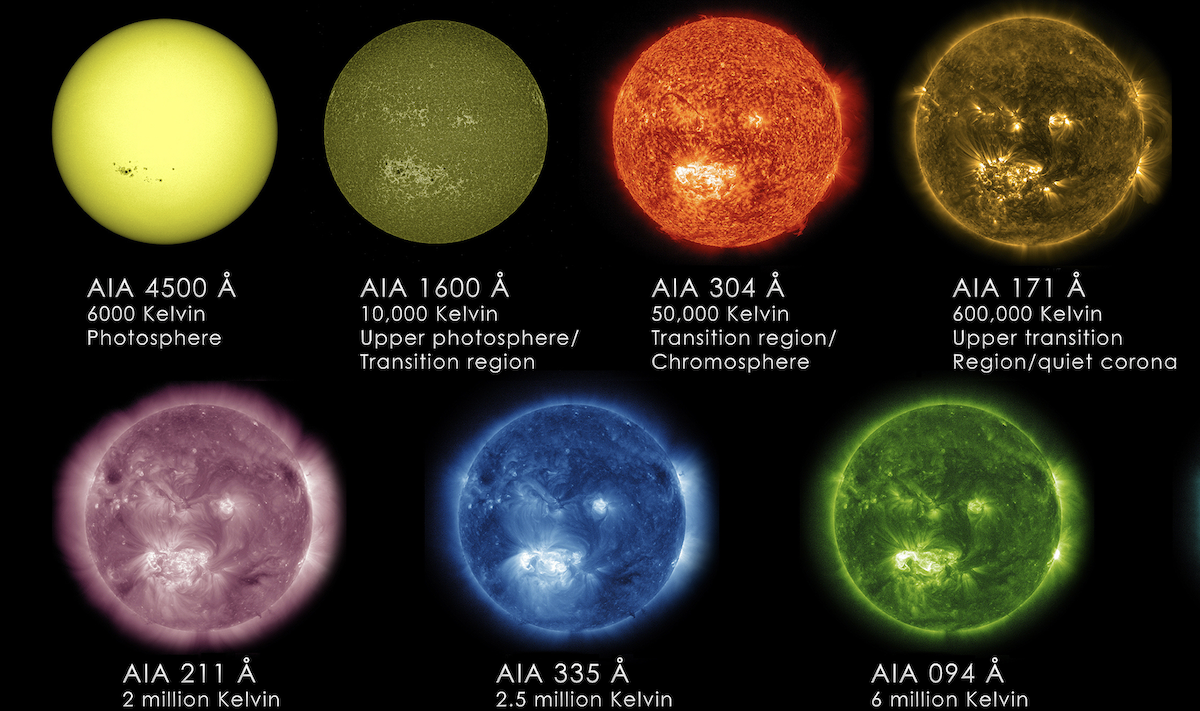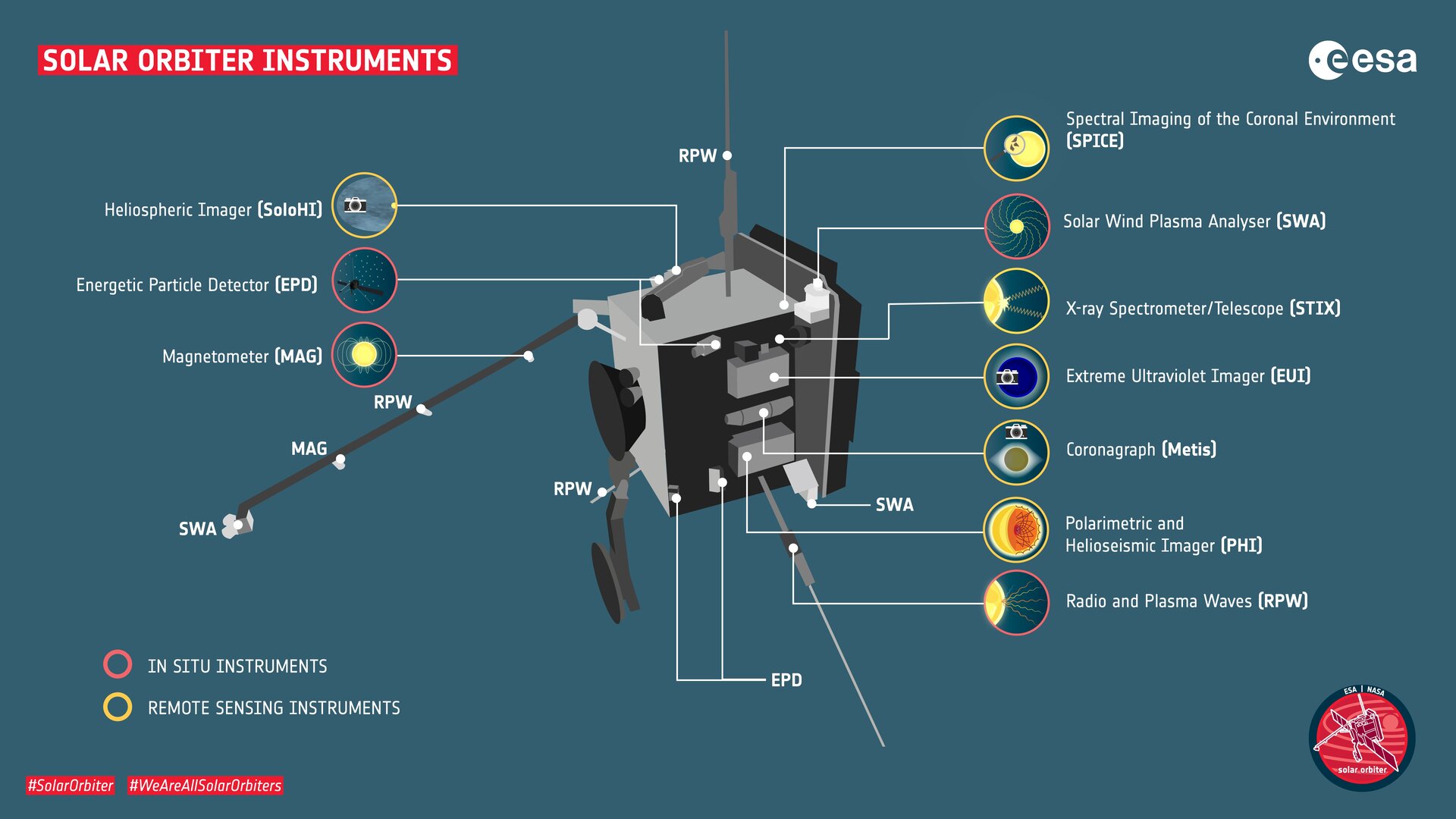Staring into the depths of the Sun with ultraviolet eyes

- The Solar Orbiter mission has taken a series of beautiful UV images of the Sun, which has a series of complex and extremely hot atmospheric layers.
- By taking images at various UV colors, the different layers can be revealed and studied.
- The craft and its mission are shaped by the challenge of the sun’s blazing heat.
The images recently transmitted back to Earth by the European Space Agency’s Solar Orbiter must be seen to be believed. The largest of them exposes the awesome chaos of the Sun’s surface. Above a soup of glowing whorls, million-degree tendrils of plasma arc and dance out into space. Zooming in reveals the fine details, the strands of arc structure, and the curls of terrifying vortices. These stunning views are all invisible to our eyes. But by capturing and imaging ultraviolet (UV) light, the probe’s cameras can slice through the layers of the Sun’s atmosphere to reveal the mysterious physics beneath.
Before we dive in, a quick refresher: SOL 101, if you will. The Sun’s innermost visible layer is the photosphere. Its opaque surface produces most of the sunlight we see on Earth’s surface and hosts sunspots. The temperature there is roughly 5,800 degrees Kelvin (about 10,000 degrees Fahrenheit), quite cold for the Sun. Above the photosphere is the chromosphere, which is named for its wild red color and is observable during solar eclipses. It has very low density and a highly variable temperature. A thin, poorly understood transition layer then leads to the corona. The corona is the outermost layer of the Sun’s atmosphere. This is where incredibly hot plasma roars, solar flares erupt, and giant bursts of material are ejected into space at a million miles an hour.
Imaging these layers requires cameras sensitive to different colors, or wavelengths, of light. Each color is produced by processes within a particular solar layer, and passes through the layers above to reach space where we capture it. This concept is beautifully illustrated by a NASA image.
On Earth, the human eye is sensitive to see the light of the photosphere. This is the orange-yellow ball with dark sunspots, visible on the top row, third from left, and on the middle row on the far left. In the higher layers, powerful energetic processes heat and ionize — strip electrons away from — gas molecules to form a burning plasma. This process emits light of very certain colors. These are the ultraviolet colors that we can’t see, but our cameras can.
Like most astronomy images, the black-and-white impressions of the UV light are false-colored so that they can be analyzed and appreciated. This process is somewhat like a medical X-ray: you can’t see the X-rays themselves, but you can see the image of the relative intensity of their flux, which is left behind on a piece of X-ray film. Two particular instruments aboard the Solar Orbiter recently relayed back UV portraits of the Sun.
The first is the Extreme Ultraviolet Imager (EUI) camera system. (For the curious, here’s a scientific discussion of every single detail.) This instrument took the enormous 9148×9112 pixel image of the entire Sun at a wavelength of 174 Angstroms (Å). The Angstrom is a scientific unit for the crest-to-crest distance of the light wave, and 174 of them equal about one one-thousandth the width of an average cell in the human body. The smallest light wave our eyes can see is near 3800 Å — 20 times larger than the wavelength used for the EUI image.
The smaller the wavelength of a light wave, the higher its energy. 174 Å is so small and so energetic that it is at the top of the UV spectrum, with nearly the energy necessary for promotion to X-ray. Fortunately for us, the Earth’s atmosphere blocks this high energy light in the extreme UV spectrum. Lower energy UV light, with larger wavelength, penetrates the atmosphere sufficiently to impart sunburn.
The EUI image captures the transition layer and the cooler parts of the corona layer in extreme detail. Another instrument, the Spectral Imaging of the Coronal Environment (SPICE), takes images that see multiple sub-layers of the corona layer. Here’s the complete scientific description. The SPICE instrument’s images demonstrate photography at multiple invisible wavelengths. Its UV-sensitive camera lies behind a diffraction grating that splits light into beams of different colors, like a prism. This allows it to take pictures at a range of selected wavelengths, about 705-790 Å and 970-1050 Å.

You can see a set of four images — built up of the entire sun, at four single wavelengths — here. These wavelengths are chosen for a specific reason. They correspond to the atomic emission of plasma at a range of temperatures between roughly 10,000 and more than 1 million K; roughly double those numbers for degrees Fahrenheit. Scientific analysis of these varying wavelength SPICE images will shed light on several solar processes.
The distribution and evolution of UV light tracks the evolving plasma in the corona. This allows the density, flow, and elemental composition of the plasma to be analyzed. For instance, the redshift or blueshift of the UV light can reveal the velocity of the plasma particles in the filament. The behavior of the filaments, their temperature, and the overall temperature gradient across the solar atmosphere are areas beyond our current scientific understanding. This data should facilitate improved explanations.
UV cameras aren’t the only fascinating technology on the Solar Orbiter. Flying close to the Sun places it in a ceaseless and scalding bath of sunlight, requiring specialized designs for the craft and its instruments. One side always faces the Sun. This side is covered with reflective foil and thermal shielding, dotted with small doors that can be briefly opened to collect light for the onboard instruments.
The solar flux can be so intense that the solar panels must rotate to prevent overheating, and the doorways to the cameras must be extra wide so that light can still pass when they expand from heating. On the far side, the instruments themselves cluster in the shade away from the heat. SPICE is designed so that infrared light that is not imaged passes completely through the craft and back out into space without depositing heat.
Since its launch aboard an Ariane 5 rocket in February of 2020, Solar Orbiter has followed a series of elliptical orbits that send the craft diving toward the Sun and then coasting back up its gravity well to roughly the distance of the Earth. Along this revolving ride it will continue to transmit images of the Sun for the next several years. Astronomers and solar physicists hope these images will help peel back the layers of the mysterious glowing sphere that sustains our tiny speck of life.





